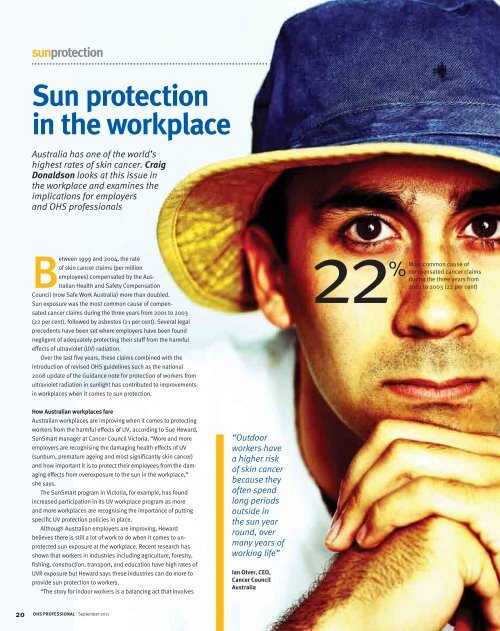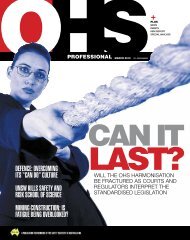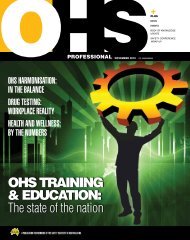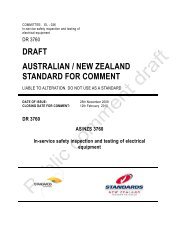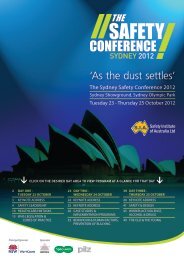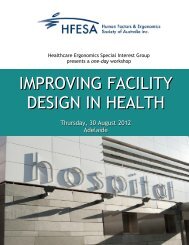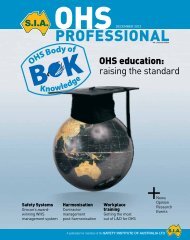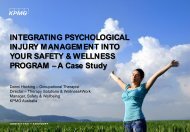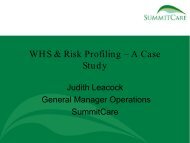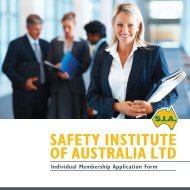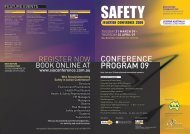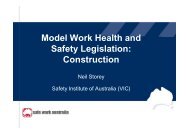Workplace bullying - Safety Institute of Australia
Workplace bullying - Safety Institute of Australia
Workplace bullying - Safety Institute of Australia
You also want an ePaper? Increase the reach of your titles
YUMPU automatically turns print PDFs into web optimized ePapers that Google loves.
sunprotection<br />
Sun protection<br />
in the workplace<br />
<strong>Australia</strong> has one <strong>of</strong> the world’s<br />
highest rates <strong>of</strong> skin cancer. Craig<br />
Donaldson looks at this issue in<br />
the workplace and examines the<br />
implications for employers<br />
and OHS pr<strong>of</strong>essionals<br />
Between 1999 and 2004, the rate<br />
<strong>of</strong> skin cancer claims (per million<br />
employees) compensated by the <strong>Australia</strong>n<br />
Health and <strong>Safety</strong> Compensation<br />
Council (now Safe Work <strong>Australia</strong>) more than doubled.<br />
Sun exposure was the most common cause <strong>of</strong> compensated<br />
cancer claims during the three years from 2001 to 2003<br />
(22 per cent), followed by asbestos (21 per cent). Several legal<br />
precedents have been set where employers have been found<br />
negligent <strong>of</strong> adequately protecting their staff from the harmful<br />
effects <strong>of</strong> ultraviolet (UV) radiation.<br />
Over the last five years, these claims combined with the<br />
introduction <strong>of</strong> revised OHS guidelines such as the national<br />
2008 update <strong>of</strong> the Guidance note for protection <strong>of</strong> workers from<br />
ultraviolet radiation in sunlight has contributed to improvements<br />
in workplaces when it comes to sun protection.<br />
22%<br />
Most common cause <strong>of</strong><br />
compensated cancer claims<br />
during the three years from<br />
2001 to 2003 (22 per cent)<br />
How <strong>Australia</strong>n workplaces fare<br />
<strong>Australia</strong>n workplaces are improving when it comes to protecting<br />
workers from the harmful effects <strong>of</strong> UV, according to Sue Heward,<br />
SunSmart manager at Cancer Council Victoria. “More and more<br />
employers are recognising the damaging health effects <strong>of</strong> UV<br />
(sunburn, premature ageing and most significantly skin cancer)<br />
and how important it is to protect their employees from the damaging<br />
effects from overexposure to the sun in the workplace,”<br />
she says.<br />
The SunSmart program in Victoria, for example, has found<br />
increased participation in its UV workplace program as more<br />
and more workplaces are recognising the importance <strong>of</strong> putting<br />
specific UV protection policies in place.<br />
Although <strong>Australia</strong>n employers are improving, Heward<br />
believes there is still a lot <strong>of</strong> work to do when it comes to unprotected<br />
sun exposure at the workplace. Recent research has<br />
shown that workers in industries including agriculture, forestry,<br />
fishing, construction, transport, and education have high rates <strong>of</strong><br />
UVR exposure but Heward says these industries can do more to<br />
provide sun protection to workers.<br />
“The story for indoor workers is a balancing act that involves<br />
“Outdoor<br />
workers have<br />
a higher risk<br />
<strong>of</strong> skin cancer<br />
because they<br />
<strong>of</strong>ten spend<br />
long periods<br />
outside in<br />
the sun year<br />
round, over<br />
many years <strong>of</strong><br />
working life”<br />
Ian Olver, CEO,<br />
Cancer Council<br />
<strong>Australia</strong><br />
20<br />
OHS PROFESSIONAL | September 2011


